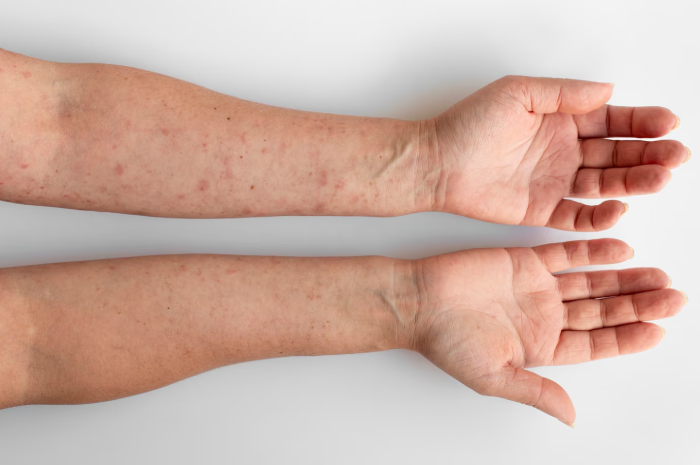Eczema
Contact
101- A, First Floor, Town Square, Above Dorabjee’s,B/H Symbiosis Law School, VIP Airport Road, Viman Nagar, Pune, Maharashtra 411014

In this article, we will explore the causes, symptoms, types, and treatment options for eczema to help you manage and alleviate this condition.
What is Eczema?
While eczema can occur anywhere on the body, it is most commonly found on the face, hands, feet, behind the knees, and inside the elbows. The severity of eczema can range from mild, with occasional flare-ups, to more severe cases that require ongoing management.
Causes and Risk Factors of Eczema
Eczema is believed to result from a combination of genetic and environmental factors. While the exact cause is not fully understood, several factors may contribute to the development of eczema:
1. Genetics
Eczema tends to run in families. People with a family history of eczema, asthma, or hay fever are more likely to develop the condition. Certain gene mutations can affect the skin’s ability to retain moisture and protect against irritants and allergens, leading to the development of eczema.
2. Immune System Dysfunction
People with eczema have an overactive immune system that responds to environmental triggers by causing inflammation and irritation. This immune response can be triggered by allergens, irritants, or infections, leading to eczema flare-ups.
3. Environmental Triggers
Various environmental factors can trigger or worsen eczema symptoms. Common triggers include:
- Allergens: Pollen, dust mites, pet dander, and mold.
- Irritants: Harsh soaps, detergents, fabrics like wool, and chemicals in household products.
- Weather: Cold, dry air or hot, humid weather can exacerbate eczema.
- Stress: Emotional stress or anxiety can worsen eczema symptoms.
- Infections: Bacterial, viral, or fungal infections can lead to eczema flare-ups.
4. Skin Barrier Dysfunction
People with eczema often have a weakened skin barrier, which makes the skin more susceptible to dryness, irritation, and infection. This is due to a lack of certain proteins and lipids in the skin that normally help keep moisture in and irritants out.
Symptoms of Eczema
The symptoms of eczema can vary from person to person, depending on the severity of the condition. Common symptoms include:
1. Itching
The most prominent symptom of eczema is intense itching. The itching can be severe and may worsen at night, making it difficult to sleep.
2. Red, Inflamed Skin
Eczema often causes patches of red, inflamed skin that may appear on various parts of the body. The affected areas can be dry, scaly, and irritated.
3. Dry Skin
People with eczema typically experience dry, flaky skin that may crack or bleed. The skin barrier dysfunction contributes to moisture loss, making the skin dry and more prone to irritation.
4. Rashes and Blisters
In more severe cases of eczema, the skin can develop rashes or small fluid-filled blisters. These blisters may break open, leading to crusting and scabbing as the skin heals.
5. Thickened Skin
Over time, repeated scratching and inflammation can cause the skin to thicken and become leathery. This is called lichenification.
6. Discoloration
Eczema can cause changes in skin pigmentation, with affected areas becoming darker or lighter than the surrounding skin. This is especially common after a flare-up has healed.
Types of Eczema
There are several types of eczema, each with distinct characteristics. The most common types include:
1. Atopic Dermatitis
Atopic dermatitis is the most common form of eczema. It typically starts in childhood and can persist into adulthood. It is associated with other allergic conditions such as asthma and hay fever. The condition causes red, inflamed patches of skin that may be dry, itchy, and scaly.
2. Contact Dermatitis
Contact dermatitis occurs when the skin comes into direct contact with an irritant or allergen. There are two types:
- Irritant Contact Dermatitis: Caused by exposure to substances like soaps, detergents, or chemicals that damage the skin.
- Allergic Contact Dermatitis: Caused by an allergic reaction to substances like nickel, fragrances, or certain plants.
3. Dyshidrotic Eczema
Dyshidrotic eczema affects the hands and feet and is characterized by the appearance of small, itchy blisters. These blisters can cause intense itching and discomfort.
4. Nummular Eczema
Nummular eczema is characterized by coin-shaped patches of red, itchy, and inflamed skin. It can occur after an injury or skin infection, and it is more common in older adults.
5. Seborrheic Dermatitis
Seborrheic dermatitis affects areas of the body that have a lot of sebaceous (oil) glands, such as the scalp, face, and upper chest. It causes red, scaly patches and can result in dandruff when it affects the scalp.
